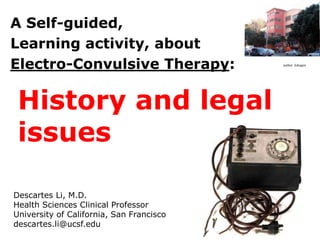1 ect hx+legal
- 1. A Self-guided, Learning activity, about Electro-Convulsive Therapy: author: Johagen Descartes Li, M.D. Health Sciences Clinical Professor University of California, San Francisco descartes.li@ucsf.edu History and legal issues
- 2. Objectives âĒ Know that Meduna, Cerletti, and Kalinowsky developed ECT and led its introduction to the U.S. in 1940. âĒ Realize that ECT is specifically regulated by California Law, AB1032. âĒ Understand that ECT requires documentation by two Board-certified psychiatrists or neurologists. âĒ Know that a detailed explanation of ECT must occur 24 hours before consent form can be signed By the end of this independent learning activity, the learner will:
- 3. History of ECT 1932: Ladislas Meduna observed cell over- and under- growth in brains of patients with epilepsy and schizophrenia, resp. 1933: Animal trials to find medication that could reliably induce seizures 1934: First trial of camphor induced seizures in humans Ladislas J. Meduna (1896â 1964), Hungarian neurologist and neuropathologist, http://en.wikipedia.org/wiki/Ladislas_J._Meduna
- 4. History of ECT 1934: Camphor replaced by pentylenetetrazol (Metrazol) 1938: Ugo Cerletti and Lucio Bini use electricity to stimulate seizures. Ugo Cerletti (1877-1963) Italian neurologist http://en.wikipedia.org/wiki/Ugo_Cerletti
- 5. History of ECT 1940: Kalinowsky introduces ECT to the U.S. Lothar B. Kalinowsky (1899 â1992) In my opinion, these first ECT practitioners were rather freaky looking.
- 6. Current practice of ECT We have an elective in ECT!
- 7. Current practice of ECT UCSF Ambulatory Surgery Center
- 8. Electro-Convulsive Therapy About 50,000 people receive ECT each year. The number of ECT procedures performed in the U.S. exceeds coronary bypass, appendectomy or hernia repair. American Psychiatric Association Committee on Electroconvulsive Therapy. The Practice of Electroconvulsive Therapy: Recommendations for Treatment, Training, and Privileging. 2nd ed. Washington, DC: American Psychiatric Association; 2001.
- 9. ASC Reception and Waiting Room
- 10. Legal Issues: California 1977 â Assembly Bill 4481, severely restricts use of ECT in California [Legal challenge by Association for Convulsive Therapy, led to replacement by less restrictive AB1032]
- 11. Legal Issues: California 1982 â Berkeley, California passes referendum: administration of ECT punishable by a fine of $500 or 6m in prison. [Later reversed by Alameda County Superior Court] 1991 â San Francisco Board of Supervisors passes a resolution against the use or financing of ECT [this resolution has little practical effect]
- 12. Legal Issues: ECT in California âĒRegulated by State law âĒRequires documentation by two BC psychiatrists [or neurologists] every 30 days âĒ Detailed explanation of procedure must occur 24 hours before consent form can be signed
- 13. Legal Issues: ECT in California âĒ Family must be notified, or notification of family must be specifically rejected by the patient âĒ Banned for minors less than 12
- 14. Summary âĒ Meduna developed seizure treatments for schizophrenia âĒ Cerletti developed ECT âĒ ECT is specifically regulated by California Law, AB1032. âĒ ECT requires documentation by two Board-certified psychiatrists or neurologists. âĒ Detailed explanation of ECT must occur 24 hours before consent form can be signed
- 15. Sherwin Nuland, M.D., on ECT










![Legal Issues: California
1977 â Assembly Bill 4481,
severely restricts use of ECT in
California
[Legal challenge by Association for
Convulsive Therapy, led to
replacement by less restrictive
AB1032]](https://image.slidesharecdn.com/1ecthxlegal-150406125113-conversion-gate01/85/1-ect-hx-legal-10-320.jpg)
![Legal Issues: California
1982 â Berkeley, California passes
referendum:
administration of ECT punishable by a fine of
$500 or 6m in prison.
[Later reversed by Alameda County Superior
Court]
1991 â San Francisco Board of Supervisors
passes a resolution against the use or
financing of ECT
[this resolution has little practical effect]](https://image.slidesharecdn.com/1ecthxlegal-150406125113-conversion-gate01/85/1-ect-hx-legal-11-320.jpg)
![Legal Issues:
ECT in California
âĒRegulated by State law
âĒRequires documentation by two BC
psychiatrists [or neurologists] every 30 days
âĒ Detailed explanation of procedure must
occur 24 hours before consent form can be
signed](https://image.slidesharecdn.com/1ecthxlegal-150406125113-conversion-gate01/85/1-ect-hx-legal-12-320.jpg)


